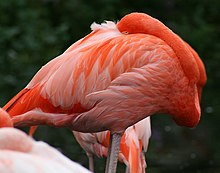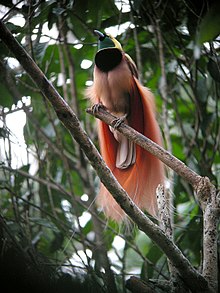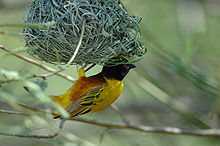 Resting and roosting
Resting and roosting Many birds, like this American Flamingo, tuck their head into their back when sleepingThe high metabolic rates of birds during the active part of the day is supplemented by rest at other times. Sleeping birds often use a type of sleep known as vigilant sleep, where periods of rest are interspersed with quick eye-opening 'peeks', allowing them to be sensitive to disturbances and enable rapid escape from threats.[126] Swifts are believed to be able to sleep in flight and radar observations suggest that they orient themselves to face the wind in their roosting flight.[127] It has been suggested that there may be certain kinds of sleep which are possible even when in flight.[128] Some birds have also demonstrated the capacity to fall into slow-wave sleep one hemisphere of the brain at a time. The birds tend to exercise this ability depending upon its position relative to the outside of the flock. This may allow the eye opposite the sleeping hemisphere to remain vigilant for predators by viewing the outer margins of the flock. This adaptation is also known from marine mammals.[129] Communal roosting is common because it lowers the loss of body heat and decreases the risks associated with predators.[130] Roosting sites are often chosen with regard to thermoregulation and safety.[131]
Many sleeping birds bend their heads over their backs and tuck their bills in their back feathers, although others place their beaks among their breast feathers. Many birds rest on one leg, while some may pull up their legs into their feathers, especially in cold weather. Perching birds have a tendon locking mechanism that helps them hold on to the perch when they are asleep. Many ground birds, such as quails and pheasants, roost in trees. A few parrots of the genus Loriculus roost hanging upside down.[132] Some hummingbirds go into a nightly state of torpor accompanied with a reduction of their metabolic rates.[133] This physiological adaptation shows in nearly a hundred other species, including owlet-nightjars, nightjars, and woodswallows. One species, the Common Poorwill, even enters a state of hibernation.[134] Birds do not have sweat glands, but they may cool themselves by moving to shade, standing in water, panting, increasing their surface area, fluttering their throat or by using special behaviours like urohidrosis to cool themselves.
Breeding
 Social systems
Social systems Like others of its family the male Raggiana Bird of Paradise has elaborate breeding plumage used to impress females.[135]Ninety-five percent of bird species are socially monogamous. These species pair for at least the length of the breeding season or—in some cases—for several years or until the death of one mate.[136] Monogamy allows for biparental care, which is especially important for species in which females require males' assistance for successful brood-rearing.[137] Among many socially monogamous species, extra-pair copulation (infidelity) is common.[138] Such behaviour typically occurs between dominant males and females paired with subordinate males, but may also be the result of forced copulation in ducks and other anatids.[139] For females, possible benefits of extra-pair copulation include getting better genes for her offspring and insuring against the possibility of infertility in her mate.[140] Males of species that engage in extra-pair copulations will closely guard their mates to ensure the parentage of the offspring that they raise.[141]
Other mating systems, including polygyny, polyandry, polygamy, polygynandry, and promiscuity, also occur.[39] Polygamous breeding systems arise when females are able to raise broods without the help of males.[39] Some species may use more than one system depending on the circumstances.
Breeding usually involves some form of courtship display, typically performed by the male.[142] Most displays are rather simple and involve some type of song. Some displays, however, are quite elaborate. Depending on the species, these may include wing or tail drumming, dancing, aerial flights, or communal lekking. Females are generally the ones that drive partner selection,[143] although in the polyandrous phalaropes, this is reversed: plainer males choose brightly coloured females.[144] Courtship feeding, billing and allopreening are commonly performed between partners, generally after the birds have paired and mated.[50]
Territories, nesting and incubation
See also: Bird nestMany birds actively defend a territory from others of the same species during the breeding season; maintenance of territories protects the food source for their chicks. Species that are unable to defend feeding territories, such as seabirds and swifts, often breed in colonies instead; this is thought to offer protection from predators. Colonial breeders defend small nesting sites, and competition between and within species for nesting sites can be intense.[145]

All birds lay amniotic eggs with hard shells made mostly of calcium carbonate.[39] Hole and burrow nesting species tend to lay white or pale eggs, while open nesters lay camouflaged eggs. There are many exceptions to this pattern, however; the ground-nesting nightjars have pale eggs, and camouflage is instead provided by their plumage. Species that are victims of brood parasites have varying egg colours to improve the chances of spotting a parasite's egg, which forces female parasites to match their eggs to those of their hosts.[146]
Bird eggs are usually laid in a nest. Most species create somewhat elaborate nests, which can be cups, domes, plates, beds scrapes, mounds, or burrows.[147] Some bird nests, however, are extremely primitive; albatross nests are no more than a scrape on the ground. Most birds build nests in sheltered, hidden areas to avoid predation, but large or colonial birds—which are more capable of defence—may build more open nests. During nest construction, some species seek out plant matter from plants with parasite-reducing toxins to improve chick survival,[148] and feathers are often used for nest insulation.[147] Some bird species have no nests; the cliff-nesting Common Guillemot lays its eggs on bare rock, and male Emperor Penguins keep eggs between their body and feet. The absence of nests is especially prevalent in ground-nesting species where the newly hatched young are precocial.
Nest of an Eastern Phoebe that has been parasitised by a Brown-headed CowbirdIncubation, which optimises temperature for chick development, usually begins after the last egg has been laid.[39] In monogamous species incubation duties are often shared, whereas in polygamous species one parent is wholly responsible for incubation. Warmth from parents passes to the eggs through brood patches, areas of bare skin on the abdomen or breast of the incubating birds. Incubation can be an energetically demanding process; adult albatrosses, for instance, lose as much as 83 grams (2.9 oz) of body weight per day of incubation.[149] The warmth for the incubation of the eggs of megapodes comes from the sun, decaying vegetation or volcanic sources.[150] Incubation periods range from 10 days (in woodpeckers, cuckoos and passerine birds) to over 80 days (in albatrosses and kiwis).[39]
Parental care and fledging
At the time of their hatching, chicks range in development from helpless to independent, depending on their species. Helpless chicks are termed altricial, and tend to be born small, blind, immobile and naked; chicks that are mobile and feathered upon hatching are termed precocial. Altricial chicks need help thermoregulating and must be brooded for longer than precocial chicks. Chicks at neither of these extremes can be semi-precocial or semi-altricial.
No comments:
Post a Comment